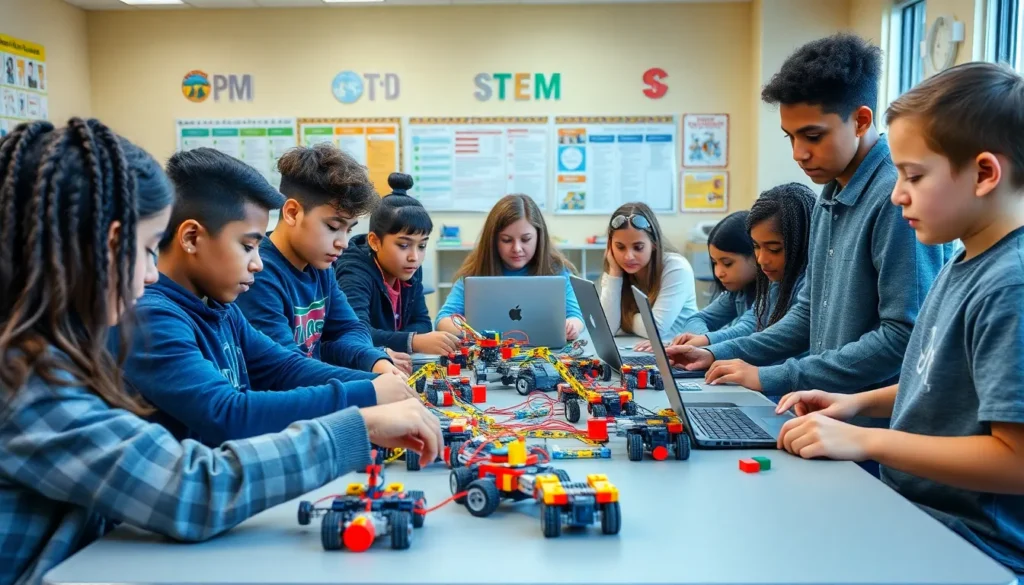In a world where robots are no longer just for sci-fi movies, educational robotics technology is revolutionizing the way students learn. Imagine classrooms buzzing with excitement as kids build their own robots, turning complex concepts into hands-on experiences. It’s like giving them a backstage pass to the future—minus the awkward celebrity encounters.
Table of Contents
ToggleOverview of Educational Robotics Technology
Educational robotics technology plays a crucial role in enhancing learning experiences for students. This technology integrates science, technology, engineering, and mathematics (STEM) principles, offering a comprehensive curriculum. Engaging with robotics allows students to tackle real-world problems, fostering critical thinking and problem-solving skills.
Robots serve as tools for exploration and creativity. Students design, build, and program their robots, which leads to a deeper understanding of concepts such as coding and mechanics. Classrooms benefit from the dynamic interaction between students and their robotic creations, resulting in higher levels of engagement.
Robotics competitions further enhance learning opportunities. Participation in these events encourages teamwork and collaboration, as students often work in groups to achieve common goals. This competitive aspect fuels excitement and motivates students to delve deeper into their projects.
Various educational robotics kits, such as LEGO Mindstorms and VEX Robotics, cater to different skill levels, ensuring inclusivity. These kits provide an easy entry point for beginners while offering advanced options for experienced learners. Teachers incorporate these resources into their lesson plans, thus supporting diverse educational needs.
Integrating educational robotics technology into schools challenges traditional teaching methods. Classrooms evolve into environments where hands-on learning is paramount. As educational institutions continue adopting this technology, students gain valuable skills that prepare them for future careers in technology and engineering fields.
Benefits of Educational Robotics

Educational robotics technology offers numerous advantages for students. It enhances learning experiences by incorporating interactive elements that make education more exciting.
Enhanced Learning Engagement
Hands-on activities like building and programming robots captivate students’ attention. Engagement increases when they work with tangible materials, creating a direct connection to theoretical concepts. Students often express more enthusiasm in lessons that involve robotics. They become motivated to explore engineering and programming principles. Robotics projects encourage experimentation and creativity, promoting a dynamic learning environment that fosters curiosity.
Development of Critical Skills
Robotics education nurtures essential skills for the future. Problem-solving abilities strengthen as students encounter challenges while designing and programming robots. Critical thinking emerges when analyzing functionalities and overcoming obstacles. Collaboration plays a crucial role in group projects, allowing students to develop teamwork skills. Furthermore, they enhance technical literacy by learning coding and mechanical principles. Overall, these skills prepare students for various STEM career paths.
Types of Educational Robotics
Educational robotics technology encompasses various components and platforms, allowing students to engage deeply in their learning experiences. Different types of robotics exist, each serving unique educational purposes.
Hardware Components
Educational robotics hardware comprises physical elements that facilitate hands-on learning. Robotics kits such as LEGO Mindstorms, VEX Robotics, and Ozobot feature essential parts like motors, sensors, and structural elements. Sensor types may include ultrasonic, infrared, and touch sensors, which help robots interact with their environment. Motors provide movement, enabling students to design dynamic robots. Structural components such as beams and connectors allow students to build customized structures. Comprehensive hardware kits cater to diverse skill levels, ensuring that students can explore robotics concepts effectively.
Software Platforms
Software platforms serve as the programming backbone for educational robotics. Popular platforms like MIT’s Scratch, Blockly, and ROBOTC provide accessible interfaces for students to code robot behaviors. Scratch utilizes a block-based visual programming approach, simplifying coding for beginners. Blockly offers similar functionality, emphasizing user-friendly coding through drag-and-drop blocks. Advanced platforms like Python are available for more experienced learners, promoting a deeper understanding of coding principles. These software platforms foster innovative thinking, allowing students to bring their robotic creations to life through programming.
Application in Educational Settings
Educational robotics technology plays a vital role across varying educational levels, fostering engagement and skill development in students. Emphasis on hands-on learning shapes students’ understanding of complex concepts.
Elementary Education
In elementary education, robotics introduces fundamental STEM concepts through interactive activities. Students often work with age-appropriate kits, such as LEGO Boost or Bee-Bot, enabling them to grasp basic programming and engineering principles. With simple coding tasks, children enhance their problem-solving skills while collaborating on group projects. Teachers integrate robotics activities into regular lessons, allowing students to learn through play and exploration. By participating in robot-building challenges, kids express creativity and gain confidence in their abilities, setting the stage for future learning.
Higher Education
Robotics technology becomes more sophisticated in higher education settings, where students tackle advanced engineering projects. University programs often utilize robotics labs equipped with high-end kits like VEX Robotics and Arduino. These resources empower students to design and program complex robots, preparing them for careers in technology and engineering. Participation in research projects promotes critical thinking and collaboration among students. Moreover, internships with tech companies provide practical experience, bridging the gap between classroom learning and industry expectations. Students emerge with a comprehensive skill set, ready to contribute to the evolving tech landscape.
Challenges in Implementing Educational Robotics
Implementing educational robotics presents several challenges that schools and educators encounter.
Cost and Accessibility
Costs often deter schools from adopting robotics programs. Educational robotics kits, while beneficial, can be expensive, especially for underfunded institutions. Additionally, funding limitations restrict access to necessary resources and training for both educators and students. Accessibility can also vary greatly, with urban schools often having better access to programs and technologies than rural ones. To make a meaningful impact, schools need to address budget constraints and strive for equitable distribution of robotics education across diverse demographics.
Curriculum Integration
Integrating robotics into existing curricula poses its own difficulties. Teachers often struggle to find ways to mesh robotics with traditional subjects effectively. Variation in teaching methodologies complicates this integration further. Moreover, educators may lack the training needed to align robotics activities with educational standards, leading to inconsistent learning experiences. Successful curriculum integration requires well-defined objectives, professional development for instructors, and a collaborative approach that encompasses various subject areas. Exploring interdisciplinary strategies can enhance students’ learning by linking robotics with science, technology, engineering, and mathematics.
Educational robotics technology is reshaping how students engage with learning. By fostering hands-on experiences that blend STEM principles with creativity and problem-solving, it cultivates a new generation of thinkers and innovators. The collaborative nature of robotics projects not only enhances technical skills but also promotes teamwork and communication among peers.
As schools continue to embrace this technology, the focus on interactive learning environments will only grow. While challenges like cost and curriculum integration remain, the potential benefits of educational robotics far outweigh these obstacles. This evolution in education equips students with the essential skills needed for future careers in an increasingly tech-driven world.










